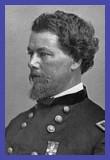
Contemporary drawing of Ewell's Confederates surrendering at Sayler's Creek
A Summary of the
Battles of Sayler's Creek

Contemporary drawing of Ewell's Confederates
surrendering at Sayler's Creek
"My God. Has the
army been dissolved?"
- R.E. Lee while surveying the survivors of the Sayler's Creek
battles.
On 6 April '65, the A.N.V. continued its westward flight. After halting at Amelia Courthouse, Lee's army conducted a night march from there on 5 April '65. General Lee had tried to escape south to Jetersville, but quick marches and a strong showing by Sheridan's Cavalry and the Fifth Corps at Jetersville persuaded Lee to continue westward via Amelia Springs in hopes of finding another route to the south.




Gen.
Phillip Gen.
Charles Gen.
Andrew Gen. Horatio
Sheridan
Griffin
Humpreys
Wright
led 5th Corps led
2d Corps led 6th Corps
The Second and Sixth Corps joined the Federal cavalry and the Fifth Corps at Jetersville. When the A.N.V. moved away from Jetersville, the Federals continued their pursuit. The Second Corps marched north to Amelia Springs and tailed the A.N.V. through Deatonsville. The Fifth and Sixth Corps marched south, then westward on a route parallel to the A.N.V.'s line of march. When the Fifth Corps reached the Genito Road (Hwy 616), it ventured southward, then westward continuing the parallel route in an effort to get in front of the A.N.V. When the Sixth Corps reached the Genito Road, it commenced an intercept course north towards the tail of the A.N.V.





Gen. R.E. Lee Gen.
James Gen. Richard Gen. Richard
Gen. John B.
Longstreet Anderson
Ewell Gordon
At the head of the Confederate column was General Lee. The first corps in the column was Longstreet with his combined First and Third (Hill's) Corps. Next was Anderson's Fourth Corps composed of the Divisions of B.R. Johnson and Pickett. Next was Ewell's Reserve Corps followed by the army's wagon train. Protecting the rear was Gordon's Second Corps.
As Federal skirmishers of the Federal Second Corps compelled Gordon's troops to stop and fight, the corps of Longstreet, Anderson, and Ewell continued marching. This created a gap between Gordon the and rest of the A.N.V. At Holt's (or Hott's) Corner, the A.N.V. continued its southwesterly march straight through this intersection. At the direction of General Ewell, the army's trains turned right at Holt's Corner and proceeded on the Jamestown Road (Hwy 618). Gordon fought a delaying action at this intersection in an effort to buy time for the A.N.V. and the trains. Eventually, Gordon turned right at the intersection and followed the army's trains northwesterly on the Jamestown Road.
The Federal Second Corps followed Gordon up the Jamestown Road. Eventually, the trains would tangle at the double bridges which span the confluence of the Big and Little Sayler's Creeks near the Appomattox River. Gordon's Corps was forced to fight another delaying action against the Second Corps here. Known as the Battle of Lockett's Farm or Double Bridges, losses in this engagement were heavy: 1700 prisoners, three artilery pieces captured, 200 wagons and 70 ambulances lost, and thirteen battle flags captured by the Federals. Gordons' battle casualties are unknown. The remnants of Gordon's Corps, who escaped capture, crossed the Appomattox at High Bridge and continued to Cumberland Church where they reunited with the A.N.V. on 7 April '65.
When the Sixth Corps, traveling northwesterly on the Jamestown Road, arrived at Holt's Corner, the corps turned left - southwesterly - in pursuit of Lee, Longstreet, Anderson, and Ewell. Lee with Longstreet marched past the Hillsman Farm and Marshall Crossroads without incident. The head of the column proceeded to Rice's Station. Anderson's and Ewell's Corps were not as fortunate.




Gen. Wesley
Gen.
Bushrod Gen.
George Gen. G.W. Custis
Merritt Johnson Pickett Lee
Three Divisions of Federal cavalry under Merritt, harassed Anderson's Corps with hit and run tactics. This forced Anderson to stop and deploy repeatedly. These deployments slowed the Anderson/Ewell column and caused a significant gap to form between them and Longstreet's unharassed corps. Into this gap poured Merritt's Cavalry. The Federal troopers blocked Anderson's route to Rice's Station and support from Longstreet. The time was after 5:00 p.m.
Anderson and Ewell conferred about how to remove Merritt's three divisions of cavalry from their path. As they conferred, the Sixth Corps formed behind Ewell. Federal cannon near the Hillsman commenced their artillery barage at 5:15 p.m. About 6:00 the Federals in front and rear of the Anderson/Ewell column attacked. The battle involving Anderson is known as Marshall's Crossroads, and the battle involving Ewell is known as the Hillsman's Farm.
Generals Ewell and Custis Lee were among the eight generals captured during the Marshall's Crossroads and Hillman's Farm battles.
Many of the troops at Marshall's Crossroads with Anderson escaped capture by fleeing to Rice's Station and rejoining Lee. Few of the troops under Ewell at the Hillsman's Farm escaped.
On the evening of 6 April '65, Longstreet's Corps plus the escapees marched to Farmville and received rations on 7 April. Continued harassment by Federal cavalry forced Lee to cross the Appomattox River at Farmville and venture north to Cumberland Church. There, Gordon's Second Corps reunited with Lee.
Two days of flight later, Federals finally blocked Lee just west of Appomattox Courthouse. With Federals at his front, left and rear, General Lee surrendered the Army of Northern Virginia. Formal surrender ceremonies for each of the respective branches of service would occur over the next three days. The storied "Gordon/Chamberlain" surrender of the infantry occurred on Wednesday, 12 April 1865.
Return to the Federal Campaign Page for Sayler's Creek
background by Glyph Web Graphics